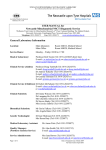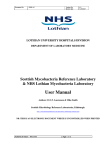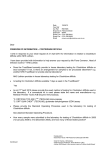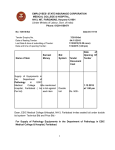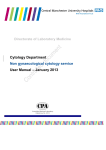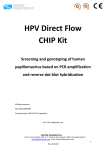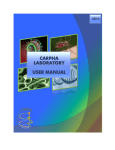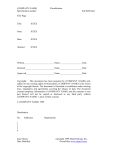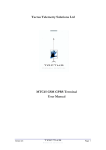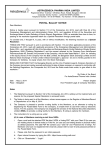Download USER MANUAL - Scotland's Health on the Web
Transcript
Doc nono HPV 64: VERSION 44 Doc HPV 64: VERSION Review date: 10/09/2016 Review date: 10/09/2016 Scottish HPV Reference Laboratory (SHPVRL) USER MANUAL Author: K Cuschieri, I Johannessen & C Moore Page 1 of 29 Author: K Cuschieri, I Johannessen & C Moore This is an electronic document which is uncontrolled when printed. Doc no HPV 64: VERSION 4 Review date: 10/09/2016 CONTENTS Glossary Page 3 Purpose Page 4 Scope of service Page 4 Contact details & hours of work Page 5 HPV tests offered Page 6 Submission of specimens Page 8 Information for Scottish Cytology Labs - HPV Testing as a test of cure of treatment Page 10 HPV types detected with different HPV tests Page 17 Factors affecting performance of HPV test Page 18 Additional tests Page 19 Definition of “high-risk” and “low-risk” HPV types Page 20 Reporting of results Page 23 Laboratory accreditation Page 23 External quality assurance schemes Page 23 SHPVRL and research and development Page 24 Selected publications Page 25 Appendix 1 Page 27 Appendix 2 Page 28 Appendix 3 Page 29 Page 2 of 29 Author: K Cuschieri, I Johannessen & C Moore Doc no HPV 64: VERSION 4 Review date: 10/09/2016 GLOSSARY HPV Human Papillomavirus HPS Health Protection Scotland LBC Liquid Based Cytology SCSP Scottish Cervical Screening Programme ECOSS Electronic Communication of Surveillance in Scotland NATS Nucleic Acid tests SCCRS Scottish Cervical Call Recall System FFPE Formalin Fixed Paraffin Embedded NEQAS National External Quality Assurance Scheme QCMD Quality Control in Molecular Diagnostics FDA CE IARC Food and Drug Administration Certificate European International Agency of Research on Cancer PVPapillomavirus Page 3 of 29 Author: K Cuschieri, I Johannessen & C Moore Doc no HPV 64: VERSION 4 Review date: 10/09/2016 1. PURPOSE The Scottish Human Papillomavirus Reference Laboratory (SHPVRL) is commissioned by Health Protection Scotland (HPS) to provide a comprehensive service for screening and typing of Human Papillomavirus (HPV). 2. SCOPE OF SERVICE • To provide testing services to evaluate the impact of the HPV immunisation programme on the incidence and prevalence of HPV related disease and HPV infection in the Scottish population. • To provide a specialist diagnostic and expert advice service in relation to HPV for specific clinical cases where it could help inform clinical management. • To provide education and training for the wider service and develop and validate new HPV technologies; carry out quality control and external quality assurance and act as a base for research and development. • To contribute to the data and knowledge of changing epidemiology of HPV associated disease to help inform the future organisation of services to prevent cervical disease and cancer. Other elements HPV testing for the Scottish Cervical Screening Programme (SCSP) SHPVRL also provides information advice and testing services for the Scottish Cervical Screening Programme (SCSP). To this end, SHPVRL currently performs HPV testing as a test of cure of treatment. Following an early implementation phase across part of Scotland, test of cure was rolled out Nationally from the 30th April in 2012. Procedures for the delivery of HPV testing services for test of cure have been developed between SHVPRL and the Scottish Cytology Laboratories (for more detail, please see section 6 page 9) SHPVRL collaborates with partners including UK NEQAS and the English Cervical Screening Programme in the preparation of material for HPV quality assurance and validation schemes. Page 4 of 29 Author: K Cuschieri, I Johannessen & C Moore Doc no HPV 64: VERSION 4 Review date: 10/09/2016 3. CONTACT DETAILS AND HOURS OF WORK Name and Designation Telephone numbers and Email address Director 0131 242 6039 Dr Kate [email protected] Medical Consultant 0131 242 6003 Dr Ingo [email protected] Advanced Biomedical Scientist 0131 242 6005 Mrs Catherine [email protected] Specialist Biomedical Scientist 0131 242 6020 Miss Alison [email protected] Associate Clinical Scientist 0131 242 6020 Dr Christopher [email protected] Associate Clinical Scientist 0131 242 6020 Mr Daniel [email protected] Biomedical Support Worker 0131 242 6020 Mr Norman [email protected] SHPVRL Administrator Miss Kirsty Haxton 0131 242 6010 [email protected] Departmental confidential fax 0131 242 6008 Royal Mail Postal Address Scottish Human Papillomavirus Reference Laboratory (SHPVRL) Division of Laboratory Medicine Microbiology Department Edinburgh Royal Infirmary 51 Little France Crescent Edinburgh EH16 4SA Hays DX Address Dx number - 6231202 Exchange/depot - Edinburgh - 96 EH Hours of work Core laboratory hours are 9am – 5pm Monday to Friday. SHPVRL does not currently offer an out of hours service. Page 5 of 29 Author: K Cuschieri, I Johannessen & C Moore Doc no HPV 64: VERSION 4 Review date: 10/09/2016 4. HPV TESTS OFFERED 4.1 For diagnostic testing SHPVRL can perform HPV screening and/or genotyping where an HPV result would inform and support individual patient management. All detection assays used currently at SHPVRL are nucleic acid tests (NATS) - see section 7 Table 2. Current assays used for clinical testing are: For high-risk HPV detection (consensus testing of a group of high-risk types): RealTime HPV Assay (Abbott). This assay is CE marked and is one of the HPV tests that have been approved for use within the English Cervical Screening Programme. For type specific genotyping: Roche linear array HPV Genotyping Test (Roche Molecular Systems) is used. This assay is CE marked and has been validated for genotyping of cervical liquid based cytology samples. For biopsy samples the test used is the Optiplex HPV Genotyping Assay (DiaMex) which utilises luminex technology. Detailed information on characteristics of tests and appropriate bio specimens (for submission) can be found in Tables 2 and 3 respectively For further information on HPV “risk” status please see Section 9 4.2 Assays used for Surveillance Testing SHPVRL performs HPV genotyping of biopsy material and cervical liquid based cytology samples , in line with the “National Surveillance System for HPV infection and related disease in Scotland” (d 15th October 2008). Genotyping results are generated using the Optiplex HPV Genotyping Assay (Diamex). Results are communicated directly to Health Protection Scotland via Electronic Communication of Surveillance information in Scotland (ECOSS). Page 6 of 29 Author: K Cuschieri, I Johannessen & C Moore Doc no HPV 64: VERSION 4 Review date: 10/09/2016 4.3 Other available HPV Assays SHPVRL has a role in evaluating the performance of new HPV tests with a mind to establishing which may be suitable for clinical use and/or research and development, going forward. Having access to varied assays also enriches the annotation of quality materials Consequently, several in-house & commercial HPV tests are available beyond those used for diagnostic testing and surveillance and include: The Hybrid Capture 2 assay (Qiagen) - a consensus DNA based “screening” assay. Consensus mRNA based screening assays and type specific mRNA assays are also available. All new tests are subjected to validation of the technology, evaluation of performance and effectiveness appropriate to the work-stream (diagnostic, research, epidemiology). Users would be informed of any changes made in tests relating to service in advance of the next version of this user manual. Costs associated with HPV testing For NHS Boards in Scotland Finite funding has been allocated for diagnostic HPV tests relating to requests from NHS Boards in Scotland. Thus, tests are free for referrals from NHS Boards in Scotland, until the allocation is fully utilised. For NHS Boards outwith Scotland and for Private Institutions Costs have been calculated for non-Scottish NHS Boards and for private requests. Requests for undertaking HPV testing in these situations must be discussed with SHPVRL before sending specimens. Page 7 of 29 Author: K Cuschieri, I Johannessen & C Moore Doc no HPV 64: VERSION 4 Review date: 10/09/2016 5. SUBMISSION OF SPECIMENS (Individual Clinical Requests) 5.1Request form All specimens must be accompanied with the appropriate request form. Please complete the relevant SHPVRL request form for either gynaecological or nongynaecological requests. Both forms can be found in appendix 2 and 3 of this user manual and are also included as separate PDFs on the HPS website* and the RIE laboratory medicine website**. Request forms can be completed electronically or by hand. Hard copies of request forms must accompany speciments * www.hps.scot.nhs.uk/reflab/VirLabDetail.aspx?id=26 ** www.edinburghlabmed.co.uk/Specialities/reflab/hpv/Pages/default.aspx Where possible, request forms should be printed from the websites above but can be provided by SHPVRL upon request. Please use a separate request form for each patient, ensuring that all relevant fields are completed. As a minimum we require: - Patient’s Identification (Surname & Forename/CHI number) - Patient’s date of birth and gender - Specimen type/site - Consultant to whom a report should be addressed - Location and contact details of sender - Relevant clinical information Please note that if the sample is associated with the Scottish Cervical Screening programme (test of cure service) a form is not required as this workstream is organised through SCCRS - please go to section 6 for details on test of cure processes. 5.2Specimen Labelling All specimens should be labelled with the following information: - Surname & Forename - CHI number (for Scottish Referrals) - Date of birth A specimen and/or associated request form with insufficient accompanying information (as outlined above) could result in a delay in the sample being tested or the sample not being tested. Page 8 of 29 Author: K Cuschieri, I Johannessen & C Moore Doc no HPV 64: VERSION 4 Review date: 10/09/2016 5.3 Courier/transit instructions All specimens should be sent in accordance with UN 3373 Biological Substance category B transport regulations and conform to packing instructions 650 (PI650). The courier “HAYS DX” can be used to transport samples to SHPVRL (see section 3). For users sending samples accompanied with a “sample receipt form” that requires acknowledgement, SHPVRL will not confirm receipt by fax but by phone; date of call will be logged for audit purposes. 5.4Specimen types appropriate for clinical requests Table 1 - Appropriate specimens for diagnostic HPV testing. Test Specimen type Stipulations High risk HPV detection (consensus testing or “screening”) Cervical Liquid Based Cytology (LBC) sample in PreservCyt® Media in original LBC container If the original LBC container is sent, please ensure it is not required for any aspect of the cytopathology process at the sending laboratory. SHPVRL is not responsible for returning original LBC samples to the sending laboratory. OR A 3 ml “prequot”, can be removed. The term prequot refers to an aliquot that is removed from the original LBC vial before it is transferred to an automated slide processor. If prequot is sent, ensure container is labelled according to section 5.2. Furthermore, original vials should be vortexed, prior to prequot or manually inverted 6 times if no vortex available. All prequots should made using sterile plasticware. Order details for prequot tubes are in section 6.0 HPV genotyping (type specific detection) For biopsies - 2, 10 um sections of Formalin Fixed Paraffin Embedded Material placed in separate sterile 2 ml screw cap tubes (ie maximum of 1 10 um section per tube) OR Original, relevant FFPE block on which pathology diagnosis has been made in sealed, labeled plastic bag Cervical Liquid Based Cytology sample in PreservCyt® Media in original LBC container OR 3 ml prequot as described above If sending paraffin sections, it is essential to refer to “Protocol for sectioning paraffin blocks at source laboratory”(in this user manual). Paraffin sections of tissue in other fixatives (eg Bouin’s solution) and fresh tissue are not generally acceptable for HPV testing – for further information contact SHPVRL. SHPVRL will send all original blocks back to parent laboratory. If the original LBC container is sent, please ensure it is not required for any aspect of the cytopathology process at the sending laboratory. SHPVRL is not responsible for returning original LBC samples to the sending laboratory. If prequot is sent for an individual clinical request, ensure container is labelled according to section 5.2. All prequots should made using sterile plasticware. Order details for prequot tubes are in section 6.0 Other types of samples can only be accepted after prior discussion with SHPVRL. Page 9 of 29 Author: K Cuschieri, I Johannessen & C Moore Doc no HPV 64: VERSION 4 Review date: 10/09/2016 6. Information for Scottish Cytology Labs - HPV Testing as a test of cure of treatment HPV testing for women who have been treated for cervical lesions (as a test of cure) rolled-out across Scotland from April 30th 2012. HPV testing for test of cure occurs centrally at the Scottish HPV Reference Laboratory. The following section outlines: • Key information about the HPV test used • Guidance on sample/prequot preparation and secure specimen transfer • Information on the HPV test (used for test of cure) and the associated results THE HPV TEST AND ASSOCIATED RESULTS At time of preparation of this document the test that is used for Test of Cure is the Abbott RealTime High Risk HPV Test. This is a clinically validated test that has Certificate Europeanne (CE) marking and satisfies “non inferiority” criteria of Meijer et al (2009) with respect to diagnostic HPV assays. It is also one of the assays approved by the English Cervical Screening Programme for triage and test of cure. The Abbott assay tests for a group of 14 high-risk HPV types in aggregate (see detection range below), it also provides additional limited typing of HPV 16 and 18 although type specific result will not be routinely entered in SCCRS and management is according to “HR HPV positive” or “HR HPV negative” status. Detection range: 16,18,31,33,35,39,45,51,52,56,58,59, 66 and 68. The Abbott assay is based on PCR based amplification of target DNA in the sample; a positive result would indicate that the assay has detected at least one of the types listed above, a negative result would indicate that none of the types listed above are present in the sample or are present at levels below the detection limit of the assay. The assay also contains an internal cellular control to check for specimen adequacy to minimise the possibility of false negatives. Page 10 of 29 Author: K Cuschieri, I Johannessen & C Moore Doc no HPV 64: VERSION 4 Review date: 10/09/2016 The results that will be available in SCCRS will be: Definition Result in SCCRS HR HPV Positive Positive for 1 or more of the 14 high-risk types listed above HR HPV Negative Negative for any of the high-risk types listed above HPV Fail Issue with the sample, sample-processing or test - meaning definitive result could not be generated. These are the only definitive results that will map to letters. Factors that could affect test performance or interpretation The Abbott assay requires LBC sample. To allow for slight excess/repeat and for volume loss to pipetting, laboratories are required to provide a 3 ml prequot of LBC sample. The term prequot refers to an aliquot that is removed from the original LBC vial before it is transferred to an automated slide processor At time of preparation of this SOP we do not recommend that samples which have been lysed with glacial acetic acid should be submitted for HPV testing, however SHPVRL will be in touch with users, either directly or via the cytology QA group with relevant updates It is essential that laboratories prepare specimens correctly to ensure accurate and timely result generation, failure to do so will (as a minimum) delay result reporting When storing prequots prior to dispatch, temperatures in excess of 250C should be avoided. Refrigerated (40C) storage of prequots is not mandatory but will not affect the test performance. Prequots should not be frozen prior to transit. Please ensure that caps are firmly secured; given the methanol content in LBC samples minor leakage of a single sample within a batch can result in obliteration of the identifiers on all samples in the batch as well as posing a contamination risk. Leaking samples are likely to result in delayed reporting or an inability to perform the assay Page 11 of 29 Author: K Cuschieri, I Johannessen & C Moore Doc no HPV 64: VERSION 4 Review date: 10/09/2016 SAMPLE ALIQUOTING FROM LBC VIALS Where possible aliquoting should be performed in a class 1 cabinet. Howie coats and gloves should be worn and universal precautions adhered to. Attach the relevant (SCCRS) label(s) to the orange capped tube(s), vertically. The SCCRS label should be placed on the lower section of the tube with the left hand edge just above the skirt line (See Figure 1 on page 12). Thoroughly mix the sample in the original LBC vial by by vortexing or by inverting the vial six times. Using a pastette (disposable plastic pipette), remove sample from the LBC vial, and expel into the corresponding orange tube. The level of the liquid should be just over the upper right hand edge of the SCCRS label (See Figure 1) – this will constitute approximately 3 ml. Dispose of the empty pastette. Do not use a pastette for more than one sample as this will lead to cross-contamination. This is essential. Ensure lid is FIRMLY secured, store vial(s) in a designated area pending dispatch to SHPVRL External cytology labs are expected to purchase the (prequot) tubes; updated supplier information is below: Company: Abbott Molecular Product number: 4J7180 Product Description: Mastermix Tubes Unit: Pack of 150 Page 12 of 29 Author: K Cuschieri, I Johannessen & C Moore Doc no HPV 64: VERSION 4 Review date: 10/09/2016 Figure 1 - Mock up of an appropriately labeled “Prequot” Lid firmly secured Using a pastette add sample to a level equal to (or just over) the right hand edge barcode label placed vertically on side of tube Place SCCRs barcode label vertically on side of tube, with the left hand edge just above the “skirt” line MANDATORY DATA SET All prequots/samples must be labeled with the appropriate SCCRS label, this will contain: SCCRS no Cytology Lab Accession no Patient Name CHI Failure to label the prequots will make them totally unidentifiable so it is essential that correct labels be attached. SHPVRL require an additional aliquot Occasionally virology will “Require additional aliquot” from cytology and this will appear as an alert on SCCRS, this is not a definitive result and Cytology will be tasked with providing and sending a repeat aliquot of the specimen (if available). Page 13 of 29 Author: K Cuschieri, I Johannessen & C Moore Doc no HPV 64: VERSION 4 Review date: 10/09/2016 SAMPLE TRANSFER to SHPVRL (non Lothian) Prequots for test of cure should be batched where possible (Standard Hayes container will take around 12 orange capped tubes) to ensure efficiency of transfers. Tubes should be placed in Hayes DX container or approved alternative according to packaging instructions. Packaging should be in accordance with UN 3373 Biological Substance category B transport regulations and conform to packing instructions 650 (PI650). When collating a batch of aliquots for transportation to SHPVRL, the individual responsible for this task must check the SVQ to ensure there is tubes for all selected samples and there are no duplicate or inappropriate “extra” tubes for samples not on the SVQ. For each transfer, the proforma “Specimen transfer from Cytology for Test of Cure HPV testing” should be completed and dispatched with the samples, in between the biobottle and the cardboard outer. Please complete all fields other than those within “For SHPVRL use only” section. Proformas are provided by SHPVRL. One copy of the proforma should be retained in the cytology laboratory - attach to the SVQ report/list, which should be filed in chronological order. Contact courier to confirm date and time of the next uplift, remember to include the date the samples were dispatched and the tracking number in the relevant section of the proforma. For Lothian Cytology Laboratory Prequots should be stored in designated rack and transferred to SHPVRL Lab (S5251). TURNAROUND FOR RESULT REPORTING For efficiency, samples will be batched and SHPVRL will work to a turnaround of 5 working days. The enquiries function in SCCRS will enable cytology staff to check the progress/status of a particular sample. However, for specific enquiries please contact a member of SHPVRL using the details in section 3, page 4. Page 14 of 29 Author: K Cuschieri, I Johannessen & C Moore Doc no HPV 64: VERSION 4 Review date: 10/09/2016 OTHER QUESTIONS What are the time limits for test of cure HPV Testing? Tests will not be accepted less than 4 months from treatment date but there is no upper time limit for inclusion in test of cure, provided the patient has not previously been tested since treatment and there have been no further interventions What happens if a sample has been sent for test of cure in error? Inform SHPVRL by phone, it is possible to “remove” a sample from the virology module of SCCRS at any stage, even if it has been tested. The request for “removal” of a sample will appear on the audit trail. What happens if virology have amended/updated an HPV test result? If virology have updated an HPV test result an alert will appear on the Labs Home page of SCCRS. The amended virology result will automatically update the CCR final result screen and this will appear on the audit trail What happens if a sample that should have had an HPV test -as a test of cureis missed and the result has been reported in cytology? For this scenario, if cytology laboratory still has the relevant sample, an aliquot can be sent with a clinical request form (see appendix) – please write clearly in the “reason for request” section of the form that the sample relates to a “missed test of cure”. What happens if the sample is “rejected” by virology/SHPVRL? SHPVRL will inform the cytology lab if a sample has been rejected – reasons for this include insufficient volume or leakage within the transit container. A further aliquot should be provided if available. If it is not possible to provide a further aliquot, inform SHPVRL and de-select sample from the SCCRS HPV queue. Page 15 of 29 Author: K Cuschieri, I Johannessen & C Moore Doc no HPV 64: VERSION 4 Review date: 10/09/2016 Can we request additional investigations on samples? Other than repeating the Abbott assay, where required/necessary (e.g. in certain cases where an additional aliquot is required) - additional HPV tests are not offered as part of Test of Cure. If SHPVRL require an additional aliquot an alert will appear on SCCRS “Require additional aliquot for SCCRS No - etc ”. If there is no or insufficient material to send a repeat aliquot please inform SHPVRL who will update the HPV status of the result to “Fail”. Will the HPV surveillance process be affected by test of cure? The cytology laboratory collection processes for National HPV surveillance (where LBC samples from the screening population are collected over a fixed period and sent to SHPVRL) should not affect or interfere with any of the processes for test of cure. However, for any queries relating to this please contact SHPVRL. Page 16 of 29 Author: K Cuschieri, I Johannessen & C Moore Doc no HPV 64: VERSION 4 Review date: 10/09/2016 7. HPV TYPES DETECTED WITH DIFFERENT HPV TESTS Different commercial HPV tests are designed to detect a specific range of HPV types, dependent on the technology used and the primer/probe range incorporated. These are detailed in Table 2. Table 2 – Type ranges of HPV tests performed Test Methodology Frequency Turnaround time High risk HPV detection (consensus testing, cervical LBC samples) rT HPV Assay (Abbott). This is a CE marked, assay which detects 14 high-risk HPV types in aggregate and provides typing information on presence/absence of HPV 16 and 18.a Min 2 x Weekly 5 working days (clinical requests) HPV type specific genotyping (Cervical LBC samples) Linear Array HPV Genotyping testb (Roche) Weekly to fortnightly depending on number of requests 10 days Weekly 10 days HPV type specific genotyping Optiplex Multiplex HPV (Biopsy Samples – LBC Genotyping Kitc (Diamex)* samples for surveillance) 5 working days (test of cure) Turnaround time excludes weekends and public holidays a Detection Range: 16,18,31,33,35,39,45,51,52,56,58,59,66,68 b Detection range – HPV 6,11,16,18,26,31,33,35,39,40,42,45,51,52,53,54,55,56,58,59,61,62,64,66,67,68,69,70,71,72,73,81,82,83,84, HPVIS39, HPV CP6108 c Detection range – 6,11,16,18,26,3133,35,39,42,43,44,45,51,52,53,56,58,59,66,68,70,73,82 For risk status associated with the types, please see section 9. Page 17 of 29 Author: K Cuschieri, I Johannessen & C Moore Doc no HPV 64: VERSION 4 Review date: 10/09/2016 8. FACTORS AFFECTING PERFORMANCE OF HPV TEST The yield and quality of nucleic acid in cervical liquid based cytology samples collected in PreservCyt is high. However, when storing liquid based cytology samples prior to dispatch, temperatures in excess of 250C should be avoided. Refrigerated (40C) storage of prequots is not mandatory but will not affect the test performance. Liquid based cytology samples should not be frozen prior to transit. Degradation/fragmentation of nucleic acid can however impair the performance of the HPV NATs. Degradation is more associated with paraffin embedded material than with liquid based cytology samples, particularly where these have been stored in excess of 2 years. The genotyping assays used by SHPVRL incorporate amplification of a human DNA gene to control for sample quality. Thus, if a sample tests HPV negative and is also negative for the human DNA gene a result of “invalid” is generated. The RealTime HPV test also incorporates a human cellular control. For laboratories sending paraffin sections it is essential to refer to the “protocol for sectioning paraffin blocks at source laboratory” (See Appendix 3). As the downstream HPV test used for FFPE sections is very sensitive, we therefore ask laboratories to send a section from a “blank block”, if sending a section for diagnostic HPV testing to SHPVRL for the first time (to monitor any potential environmental contamination). Testing of blank sections is monitored to inform frequency of additional requests for blank sections. Page 18 of 29 Author: K Cuschieri, I Johannessen & C Moore Doc no HPV 64: VERSION 4 Review date: 10/09/2016 9. ADDITIONAL TESTS SHPVRL decision: SHPVRL may perform a confirmatory HPV test on a specimen (beyond that requested by the user) if we consider that it would aid interpretation and be of benefit to the user. An example would be performing an HPV genotyping test on a sample we received for high-risk HPV screening which screened positive. For these cases, results would be aggregated in one report. User requests: For users who wish to organise an additional examination on a sample– these may/may not be possible depending on the nature of the request and the amount of residual specimen remaining. There is no defined time limit for requesting additional examinations but (if the request is possible) their performance may affect the stated turnaround (table 2). Turnaround is based on when the specimen/request was initially received. All additional assays (whether generated in-house or requested by users) will be adjudicated on a case by case basis by a senior member of SHPVRL. Page 19 of 29 Author: K Cuschieri, I Johannessen & C Moore Doc no HPV 64: VERSION 4 Review date: 10/09/2016 10. DEFINITION OF “HIGH-RISK” AND “LOW-RISK” HPV TYPES 10.1Overview of classification. HPV types are often categorised as “high” or “low” risk according to the strength of their association with cancer. All HPV genotypes that are known to be cervical carcinogens belong to the alpha genus. Within the alpha genus, species groups (which unite related types) which have been found to contain high-risk types are alpha-5, alpha-6, alpha-7, alpha-9 and alpha-11. The evidence base which has informed the risk classifications is drawn from worldwide surveys of HPV type distribution in high grade cervical lesions and cancers. This evidence base continues to accrue and as a consequence, the classifications refine. In addition attribution of risk for rare types is challenging. 10.2 Categorisation of HPV types according to standardised grouping system for human carcinogens. In 2009 an expert working group at the International Agency for Research on Cancer (IARC) endeavoured to categorise HPV types according to a standardised grouping system for human carcinogens thus: Group 1 Group 2A Group 2B Group 3 Carcinogenic to humans Probably carcinogenic to humans Possibly carcinogenic to humans Not classifiable as to its carcinogenicity in humans. Table 3 shows the HPV types incorporated into the genotyping assays used at SHPVRL, their associated carcinogenic group (according to IARC) and risk status according to current evidence/expert opinion. Page 20 of 29 Author: K Cuschieri, I Johannessen & C Moore Doc no HPV 64: VERSION 4 Review date: 10/09/2016 Table 3 - Carcinogenic potential/risk status of HPV types detected in assays used at SHPVRL. Page 21 of 29 Author: K Cuschieri, I Johannessen & C Moore Doc no HPV 64: VERSION 4 Review date: 10/09/2016 Table 3Continued The table has been constructed from the following sources: 1 2 3 4 5 Bouvard V et al [2009] Special Report: Policy – A review of human carcinogens – part B: biological agents De Villiers et al [2004] Classification of papillomavirus. Virology 324:17-27 Bernard et al [2010] Classification of papillomaviruses based on 189 PV types and proposal of taxonomic amendments. Virology 401: 70-79. Li et al [2011] Human Papillomavirus type distribution in 30,848 invasive cervical cancers worldwide: variation by geographical region, histological type and year of publication. International Journal of Cancer 128: 927-935. Schiffman et al [2009] Classification of weakly carcinogenic Human Papillomavirus types: addressing the limits of epidemiology at the borderline. Infectious Agents and Cancer 4:8 Page 22 of 29 Author: K Cuschieri, I Johannessen & C Moore Doc no HPV 64: VERSION 4 Review date: 10/09/2016 11. REPORTING OF RESULTS Written reports are issued and sent to the requesting consultant via the Royal Mail. Emailed reports can be arranged provided the account is appropriate for secure transfer (eg nhs.net). Transfer of surveillance results will be performed directly through ECOSS. If requested, results can be telephoned in advance of the report by a senior member of SHPVRL. For advice and interpretation please contact Dr Kate Cuschieri or Dr I Johannessen using contact details in Section 3. HPV results associated with test-of cure (SCSP) are disseminated through the national IT management tool for cervical screening, the Scottish Cervical Call Recall System (SCCRS). At time or preparation of this manual we are working with SCSP Laboratory QA group to ensure that HPV results generated as a consequence of individual (gynae) clinical requests are entered on SCCRS retrospectively 12. LABORATORY ACCREDITATION SHPVRL is situated within the Directorate of Laboratory Medicine, Microbiology Laboratory which was accredited by CPA (CPA Reference Number 2496) in May 2014 and found to be in conformance with the Clinical Pathology Accreditation (UK) Ltd “Standards for the Medical Laboratory” 13. EXTERNAL QUALITY ASSURANCE SCHEMES • National External Quality Assurance (NEQAS) SHPVRL takes part in the HPV UK NEQAS scheme – this involves the testing of a panel of 4 unknown clinical samples, distributed three times per year. The scheme interrogates the screening performance of assays and is designed to support clinical testing. •Quality Control for Molecular Diagnostics (QCMD) SHPVRL takes part in the HPV QCMD scheme which involves the testing of a panel of 10 samples distributed once per year. The scheme interrogates the screening performance of assays •WHO HPV LabNet SHPVRL take part in the WHO LabNet EQA scheme. The scheme interrogates the type specific performance of assays. Page 23 of 29 Author: K Cuschieri, I Johannessen & C Moore Doc no HPV 64: VERSION 4 Review date: 10/09/2016 14. SHPVRL AND RESEARCH AND DEVELOPMENT SHPVRL has a keen interest and commitment to research and development. Particular areas of interest are: • • • Working with public health, the cervical screening programme and academia to ensure that optimal systems for both HPV surveillance and cervical disease management and prevention are available Assay evaluation and development in conjunction with NHS, academic and industrial partners Acting as clinical laboratory partners for external basic research collaborations In pursuit of the above, staff at SHPVRL work closely with the HPV Research Group in the Queens Medical Research Group (University of Edinburgh, Division of Pathology) which hosts the National HPV archive - a biobank of over 20,000 samples set up to facilitate HPV research. The archive welcomes applications for sample use from interested researchers - for further information please contact [email protected]. SHPVRL was instrumental in the creation of the Scottish HPV Investigators Network (SHINe) and contributes to its continuing activities. SHINe is a cross disciplinary forum designed to engender and deliver collaborative research on HPV. For further details, please see the SHINe Website: www.shine.mvm.ed.ac.uk. Page 24 of 29 Author: K Cuschieri, I Johannessen & C Moore Doc no HPV 64: VERSION 4 Review date: 10/09/2016 15. SELECTED PUBLICATIONS 1: Pollock KG, Kavanagh K, Potts A, Love J, Cuschieri K, Cubie H, Robertson C, Cruickshank M, Palmer TJ, Nicoll S, Donaghy M. Reduction of low- and high-grade cervical abnormalities associated with high uptake of the HPV bivalent vaccine in Scotland. Br J Cancer. 2014 Sep 2. doi: 10.1038/bjc.2014.479. 2: Ward C, Pedraza J, Kavanagh K, Johannessen I, Cuschieri K. An evaluation of the Qiagen HPV sign for the detection and genotyping of cervical lesions and oropharyngeal squamous cell carcinomas. J Virol Methods. 2014 Oct;207:128- 32. doi: 10.1016/j.jviromet.2014.07.001. 3: Cuschieri K, Brewster DH, Graham C, Nicoll S, Williams AR, Murray GI, Millan D, Johannessen I, Hardie A, Cubie HA. Influence of HPV type on prognosis in patients diagnosed with invasive cervical cancer. Int J Cancer. 2014 Apr 17. doi: 10.1002/ijc.28902. 4: Kavanagh K, Pollock KG, Potts A, Love J, Cuschieri K, Cubie H, Robertson C, Donaghy M. Introduction and sustained high coverage of the HPV bivalent vaccine leads to a reduction in prevalence of HPV 16/18 and closely related HPV types. Br J Cancer. 2014 May 27;110(11):2804-11. doi: 10.1038/ bjc.2014.198. 5: Cubie HA, Canham M, Moore C, Pedraza J, Graham C, Cuschieri K. Evaluation of commercial HPV assays in the context of post-treatment follow-up: Scottish Test of Cure Study (STOCS-H). J Clin Pathol. 2014 Jun;67(6):458-63. doi: 10.1136/jclinpath-2013-202014. Epub 2014 Jan 16. 6: Cuschieri K, Cubie H, Graham C, Rowan J, Hardie A, Horne A, Earle CB, Bailey A, Crosbie EJ, Kitchener H. Clinical performance of RNA and DNA based HPV testing in a colposcopy setting: Influence of assay target, cut off and age. J Clin Virol. 2014 Feb;59(2):104-8. doi: 10.1016/j.jcv.2013.12.001. Page 25 of 29 Author: K Cuschieri, I Johannessen & C Moore Doc no HPV 64: VERSION 4 Review date: 10/09/2016 7: Cubie HA, Cuschieri K. Understanding HPV tests and their appropriate applications. Cytopathology. 2013 Oct;24(5):289-308. doi: 10.1111/cyt.12083. Epub 2013 Sep 2. Review. PubMed PMID: 23998275. 8: Moore C, Cuschieri K, McQueen F, Duvall E, Graham C, Cubie HA. Effect of glacial acetic acid pre-treatment of cervical liquid-based cytology specimens on the molecular detection of human papillomavirus. Cytopathology. 2013 Oct;24(5):314-20. doi: 10.1111/cyt.12046 9: Junor E, Kerr G, Oniscu A, Campbell S, Kouzeli I, Gourley C, Cuschieri K. Benefit of chemotherapy as part of treatment for HPV DNA-positive but p16-negative squamous cell carcinoma of the oropharynx. Br J Cancer. 2012 Jan 17;106(2):358-65. doi: 10.1038/bjc.2011.542. Page 26 of 29 Author: K Cuschieri, I Johannessen & C Moore Doc no HPV 64: VERSION 4 Review date: 10/09/2016 APPENDIX 1 Doc No: HPV 53 Version 4. Review date: 03/07/16 Gynaecology Form Human Papillomavirus (HPV) Test Request Form (for GYNAE) Scottish Human Papillomavirus Reference Laboratory, Specialist Virology Centre, Royal Infirmary of Edinburgh, 51 Little France Crescent, Edinburgh EH16 4SA From: Sender Address: Requestor/Consultant Name (Report will be sent to this person unless otherwise stated): Address for Result Report (if different from sender address): Patient details: Date & time sample taken: Name: Hospital/Laboratory ref no: Date of birth: CHI: Date posted: Or place ID label that contains above info here Specimen: Test required: High-risk HPV screening Cervical liquid based cytology sample HPV Genotyping 2 x 10 um section of fixed biopsy Biopsy site: Please note that other biospecimen types can only be accepted after prior discussion with SHPVRL Reason for request: Referral from routine screening due to problems with cervical cytology: Referral following problems associated with colposcopy visits: Older ♀ who have not exited the SCSP because of continuing low grade (LG) disease. Persistent LG abnormality after treatment where fertility conservation is an issue Patients where there is difficulty obtaining a liquid based cytology sample e.g. Immunosuppresion, AI disease. Postmenopausal ♀ with persistent LG abnormalities attending Colposcopy, given HRT (if colp. inadequate - difficulty identifying SCJ) where LETZ shown no histological abnormality & vaginal colposcopic assessment is negative. Exceptional cases not included here, where knowledge of HPV status will influence management – these cases must be discussed at Colposcopy MDT. Details: HIV +ve patients with persistent LG abnormalities where knowledge of HR- HPV -ve status would allow expectant/ observational management Discussed: Date: For further information please contact Dr Kate Cuschieri on 0131 242 6039 or Dr Ingo Johannessen on 0131 242 6003 SHPVRL LAB USE ONLY Comments: Test code(s): Authority for issue: K Cuschieri Page 27 of 29 Author: K Cuschieri, I Johannessen & C Moore Doc no HPV 64: VERSION 4 Review date: 10/09/2016 APPENDIX 2 Doc No: HPV 54 Version 4. Review date: 03/07/16 Non-Gynae Request Form Human Papilloma Virus (HPV) Test Request Form (for non GYNAE) Scottish Human Papillomavirus Reference Laboratory, Specialist Virology Centre, Royal Infirmary of Edinburgh, 51 Little France Crescent, Edinburgh EH16 4SA From: Sender Address: Requestor/Consultant Name (Report will be sent to this person unless otherwise stated): Address for Result Report (if different from sender address): Tel (Requestor): Patient details: Hospital/Laboratory ref no: Name: Date of birth: Date & time sample taken: CHI: Sex: M Date posted: /F Specimen: Test required: High-risk HPV genotyping 2 x 10 um section of fixed biopsy Original block High-risk HPV genotyping Is this an Oropharyngeal Biopsy? Yes No If not an Oropharyngeal Biopsy, specify site: Please note that biopsies from outside the oropharynx should be discussed with SHPVRL prior to submission. p16 Status of specimen: Pos Neg Unclear Will p16 Staining be performed? Not done Yes No If p16 staining is to be performed, please let SHPVRL know the result when available. Reason for request: All cases must be discussed at multi-disciplinary team meeting Discussed: Date: For further information please contact Dr Kate Cuschieri on 0131 242 6039 or Dr Ingo Johannessen on 0131 242 6003 SHPVRL LAB USE ONLY Comments: Test code: Authority for issue: K Cuschieri Page 28 of 29 Author: K Cuschieri, I Johannessen & C Moore Doc no HPV 64: VERSION 4 Review date: 10/09/2016 APPENDIX 3 Protocol for sectioning paraffin blocks at source laboratory It is the responsibility of the sending laboratory to ensure that the relevant block which contains the lesion of interest is selected. 1. Ensure, microtome and surrounding area are cleaned thoroughly (recommended cleaner-microsol wipes) and that howie coat and gloves are worn throughout the procedure. 2. Select the relevant FFPE block and face up to ensure even surface. 3. Using a fresh blade take 10 um section and place into a 2 ml DNAse/RNAse free screw cap tube (eg sarstedt tube) or eppendorf - avoid using cryo-vials or wider diameter tubes if possible. 4. Using a new blade take and additional 10 um section and place into a second screw cap sarstedt tube 5. Tubes containing the section should be labelled with Surname, Forename, CHI and DOB as instructed in section 5.2 If sending a section to SHPVRL for the first time, use an additional (third) new blade to section a “blank” paraffin block containing no tissue and place in a separate tube. This will be tested to exclude potential environmental contamination. If a regular requestor you may be asked to send additional “blank” sections intermittently, SHPVRL will contact you with details. Page 29 of 29 Author: K Cuschieri, I Johannessen & C Moore






























